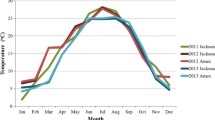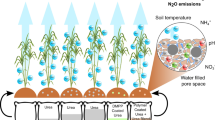Abstract
Nitrapyrin [2-chloro-6-(trichloromethyl)pyridine] has been shown to delay nitrification and may increase nitrogen (N) utilization efficiency of crops under N loss conditions. Current application recommendations suggest immediate incorporation. With fertilizer N sources such as urea and urea-ammonium nitrate (UAN) solution, immediate incorporation may not be practical. Experiments were conducted with irrigated corn (Zea mays L.) over 3 years to determine if nitrification inhibitor (NI) incorporation and contact with the fertilizer source was essential with urea and UAN to maintain efficacy of nitrapyrin and etridiazol [5-ethoxy-3-(trichloromethyl)-1,2,4-thiadiazole]. Nitrogen at a rate of 134 kg ha−1 was broadcast on a Hubbard loamy coarse sand (sandy, mixed Udorthentic Haploboroll) before planting. Nitrification inhibitors were applied at 0.56 kg ha−1 either as coating on urea, mixed with UAN, or applied in a broadcast application separate from the application of the N fertilizer. Incorporation was conducted immediately after NI application. Leaching losses, reduced N availability each year of experimentation. Nitrogen uptake from urea with no NI applied was 26% higher than uptake from UAN and resulted in 11% higher grain yields. Volatilization of urea from either N source was not apparent. Nitrapyrin and etridiazol produced similar increases in N utilization and yield. Incorporation of nitrapyrin and etridiazol was essential to obtain efficacy with both fertilizer sources. Incorporation of both NIs (averaged over NI) increased grain yields 28% with urea and 16% with UAN. Separate applications of NI provided comparable results to application with the fertilizer material if the NI was incorporated immediately.
Similar content being viewed by others
References
Boswell FC (1977) Seasonal anhydrous ammonia comparison for corn with and without nitrification inhibitor. Agron J 69: 103–106
Bremner JM (1965) Total nitrogen.In Black CA (ed.) Methods of soil analysis, pp. 1149–1176. Agronomy 9, Madison, Wisc., American Society of Agronomy
Briggs GG (1975) The behavior of the nitrification inhibitor “N-Serve” in broadcast and incorporated applications to soil. J Sci Food Agric 26: 1083–1092
Bundy LG and Bremner JM (1973) Inhibition of nitrification in soils. Soil Sci Soc Am Proc 37: 396–398
Frye WW, Blevins RL, Murdock LW, Wells KL and Ellis JH (1981) Effectiveness of nytrapyrin with surface-applied fertilizer nitrogen in no-tillage corn. Agron J 73: 287–289
Goring CIA (1962) Control of nitrification by 2-chloro-6-(trichloro-methyl) pyridine. Soil Sci 93: 211–218
Hendrickson LL, Keeney DR, Walsh LM and Liegel EA (1978) Evaluation of nitrapyrin as a means of improving N efficiency in irrigated sands. Agron J 70: 699–703
Rudert BD and Locascio SJ (1979) Differential mobility of nitrapyrin and ammonium in a sandy soil and its effect on nitrapyrin efficiency. Agron J 71: 487–489
Swezey AW and Turner GO (1962) Crop experiments on the effect of 2-chloro-6-(trichloromethyl) pyridine for the control of nitrification of ammonium and urea fertilizers. Agron J 54: 532–535
Touchton JT and Hoeft RG, Welch LF, Mulvaney DL, Odlham MG and Zajicok FE (1979a) N Uptake and corn yield as affected by applications of nitrapyrin with anhydrous ammonia. Agron J 71: 238–242
Touchton JT, Hoeft RG and Welch LF (1979b) Effect of nitrapyrin on nitrification of broadcast applied urea, plant nutrient concentrations, and corn yield. Agron J 71: 787–791
Touchton JT, Hoeft RG, Welch LF and Argyilan WL (1979c) Loss of nitrapyrin from soils as affected by pH and temperature. Agron J 71: 865–869
Turner GO, Warren LF and Andriessen FG (1962) Effect of 2-chloro-6-(trichloromethyl) pyridine on the nitrification of ammonium fertilizers in field soil. Soil Sci 94: 270–273
Redemann CT, Meikle RW and Widofsky JG (1964) The loss of 2-chloro-6-(trichloromethyl) pyridine from soil. J Agric Food Chem 12: 207–209
Warren HL, Huber DM, Nelson DW and Mann OW (1975) Stalk rot incidence and yield of corn as affected by inhibiting nitrification of fall-applied ammonium. Agron J 67: 655–662
Werner HD (1978) Irrigation scheduling checkbook method. St. Paul, Minn: Agric Ext Ser M-160
Author information
Authors and Affiliations
Additional information
Journal Paper No. 16074 Univ. of Minnesota Agric. Expt. Sta., St. Paul, MN 55108. Contribution from the Department of Soil Science. This work was supported in part by Dow Chemical U.S.A. and the Olin Corp.
Rights and permissions
About this article
Cite this article
Malzer, G.L. Incorporation of nitrification inhibitors with urea and urea-ammonium nitrate for irrigated corn. Fertilizer Research 18, 141–151 (1988). https://doi.org/10.1007/BF01049510
Received:
Accepted:
Issue Date:
DOI: https://doi.org/10.1007/BF01049510




